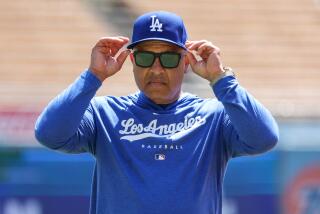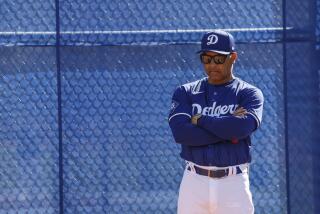$4.5-Million Monthly Outgo Problem : Roberts’ Earthly Empire Grows; So Does Overhead
- Share via
TULSA, Okla. — There is a saying here that evangelist Oral Roberts is cash poor and land rich.
He has his Oral Roberts University, with its futuristic buildings that appear to be a cross between R. Buckminster Fuller and the Jetsons. The school is paid for, land and buildings both.
He has the City of Faith medical complex across the street from the university. Its 60-story tower is the tallest in Tulsa and the gleaming gold facade rises from the gently rolling hills south of the city. The hospital complex, which includes a clinic and research center, is paid for as well, every nickel of it.
Roberts, 68, the one-time undisputed king of television evangelism, who got his start 40 years ago as a fiery tent revival faith healer, presides over a $500-million empire of brick and steel and glass, built with donations from his television “prayer partners.” Ten years ago, they numbered roughly 2.5 million viewing households.
But these days, the man credited with inventing the electronic ministry is witnessing an erosion in his following. He may have invented television preaching, but he has let others pass him by.
The latest figures for Roberts, compiled by the Arbitron Ratings Co., put his viewers at 1.1 million households and rank him a distant third to television ministers Jimmy Swaggart and Robert H. Schuller. The Tulsa Tribune, after a yearlong look at the Roberts organization, concluded early last year that viewer contributions to Roberts in fiscal 1985 had declined to $58 million, a drop of about $30 million from their level in 1980.
And that, perhaps, goes a long way toward explaining the latest furor that has engulfed Oral Roberts. The evangelist, ever a man with a new project, has said he wants to pay the freight for all of his medical students at the university, so that they will be able to enter the missionary field immediately, on graduation, debt-free. To do that, he told his followers, he needed $8 million. And, with $3.5 million of the amount raised, he pleaded with his audience twice earlier this month for the rest. If he failed, he told them, the consequence would be his own death.
The appeal set off a firestorm of protests from television executives and religious leaders, who accused Roberts of turning his show into a crass fund-raising event that resorted to scare tactics to raise what Roberts himself had called “some quick cash.”
Costly Medical Complex
In years past, Roberts probably would not have had to take such drastic measures for such a comparatively small amount of money. But as his earthly empire in Tulsa has grown, so have the costs of running it. The medical complex in particular has been a constant drain on the organization since it opened in 1981. Now, Roberts needs $4.5 million a month just to maintain what has been built.
Jan Dargatz, a spokeswoman for Roberts, said the hospital had its first break-even month in December, but that was no guarantee the corner had been turned.
“I am not sure Oral realized how expensive health care could be,” she said. “We started out with too great a stride.”
David E. Harrell Jr., who wrote a biography about Roberts, “Oral Roberts, An American Life,” put it another way: “Oral does not have an income problem, it’s an outgo problem. They have a bigger set of goals than income. The medical school is one of those.”
Bedeviled by Problems
Roberts has warned his viewers in the past that the devil was trying to close his City of Faith medical complex, and its numbers do suggest that it has been bedeviled by problems that have made it a disappointment.
It was originally built to accommodate 777 beds, but the city allotted only 294 of those because Tulsa already had more than enough hospital rooms.
Only about 120 of those beds are now occupied daily at the City of Faith, and the Roberts organization has had to resort to a certain amount of promotion to enlist patients. It has, for example, paid their air fare to Tulsa for treatment--this, for a hospital that Roberts envisioned as a center for medicine and prayer that would attract patients from all over the world.
Six years after the hospital opened its doors, Dargatz said, the Roberts organization is still trying to figure out why more “prayer partners” are not using the facilities.
Taking a Long Look
“I think it was a surprise that people who donated sizable amounts of money to build it didn’t come here to use it,” she said. “I think we’re starting to take a good long look and ask why they aren’t coming.”
They are, however, coming to Oral Roberts University. The school, which opened in 1965 with 319 students, now has an enrollment of more than 4,600. But even here, there have been problems. Last year, the university closed down its dental school and turned over the law school to fellow evangelist Pat Robertson. The medical school, with too few patients to treat, has had to struggle to maintain its accreditation.
But if Oral Roberts is not faring as well as he once did, no one is yet suggesting that he will have to sell his lavish homes in Palm Springs and Beverly Hills to pay the light bills in Tulsa. Dargatz emphasizes that Roberts’ empire is well protected because, among other things, he has $500 million in land and buildings that are paid in full.
Charles Kothe, the former dean of the university law school, said that when looking at Roberts’ business affairs, one must always keep his empire’s physical assets in mind.
Followers’ Point of View
“Some people say he’s not in touch with reality,” he said. “I know some businessmen who would be very happy with the reality he produces.”
And if the evangelist shocked or offended some groups by saying that God had told him he would die if he did not raise the needed $4.5 million by March, biographer Harrell said that Roberts’ own flock was not likely to see it that way.
Members of fast-growing Pentecostal and charismatic groups are the core of Roberts’ television congregation, he said. They took seriously Roberts’ announcement in 1980 that he had seen a 900-foot-tall Jesus, he pointed out, as well as his announcement in 1984 that he had had a 20-minute conversation with Jesus.
“The things Oral does that strike outsiders as outrageous really don’t strike his own people that way,” Harrell said.
Harrell believes that Roberts’ empire will survive, at least in the near future, but he said it is less clear that Roberts’ evangelist son, Richard, has what it takes to successfully carry out the work of the father.
New Clientele?
“Whether Richard can develop a new clientele is certainly open to question,” he said.
Roberts’ spokeswoman, Dargatz, said that the father would like to leave his ministry “in a healthy position,” and has formed an organization known as Charismatic Bible Ministries to bring fundamentalist preachers together as a unit to support him and his earthly creations, particularly the university.
“I think Oral is building lots of bridges, tying lots of knots, and that will strengthen what is out here,” she said.
To staunch the financial spillage, Roberts’ aides have taken other actions, including laying off about 130 people who worked at the City of Faith medical complex.
But the organization is also pinning its hopes on a new, partially completed “Healing Center,” being built in the shadow of the medical complex. When completed--the work is being done in stages as funds become available--it will feature a three-hour multimedia “Walk Through the Bible,” which Dargatz hopes will attract thousands of new visitors to the home of the Roberts empire.
Apple Tree and an Ark
The portion already completed includes a 23-minute walk through the first eight books of the Bible, complete with a fiery-eyed serpent, an apple tree that lights up and a Noah’s ark that rocks as it weathers the Great Flood.
Dargatz said she hoped the center would attract even more people to Tulsa and the Oral Roberts complex, already the largest tourist draw in the state. And with more people, she said, would be more money to keep the university and medical center running in the black.
“We see it as an inspirational center. It’s not an amusement park,” she said. “We’re looking at it as an endowment-building project.”
More to Read
Sign up for Essential California
The most important California stories and recommendations in your inbox every morning.
You may occasionally receive promotional content from the Los Angeles Times.










